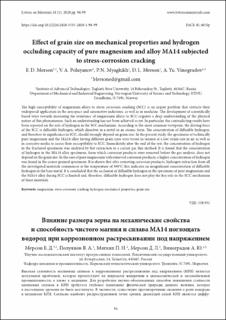| dc.contributor.author | Merson, E.D. | |
| dc.contributor.author | Poluyanov, V.A. | |
| dc.contributor.author | Myagkikh, P.N. | |
| dc.contributor.author | Merson, D.L. | |
| dc.contributor.author | Vinogradov, Alexey | |
| dc.date.accessioned | 2021-09-06T13:13:36Z | |
| dc.date.available | 2021-09-06T13:13:36Z | |
| dc.date.created | 2020-11-05T10:44:25Z | |
| dc.date.issued | 2020 | |
| dc.identifier.citation | Letters on Materials. 2020, 10 (1), 94-99. | en_US |
| dc.identifier.issn | 2218-5046 | |
| dc.identifier.uri | https://hdl.handle.net/11250/2773805 | |
| dc.description.abstract | The high susceptibility of magnesium alloys to stress corrosion cracking (SCC) is an urgent problem that restricts their widespread application in the aerospace and automotive industries, as well as in medicine. The development of scientifically based ways towards increasing the resistance of magnesium alloys to SCC requires a deep understanding of the physical nature of this phenomenon. Such an understanding has not been achieved as yet. In particular, the contradicting results have been reported on the role of hydrogen in the SCC mechanism. According to the most common viewpoint, the driving force of the SCC is diffusible hydrogen, which dissolves in a metal in an atomic form. The concentration of diffusible hydrogen, and therefore its significance in SCC, should strongly depend on grain size. In the present study, the specimens of technically pure magnesium and the MA14 alloy having different grain sizes were tested in tension at a low strain rate in air as well as in corrosive media to assess their susceptibility to SCC. Immediately after the end of the test, the concentration of hydrogen in the fractured specimens was analyzed by hot extraction in a carrier gas flux method. It is found that the concentration of hydrogen in the MA14 alloy specimens, from which corrosion products were removed before the gas analysis, does not depend on the grain size. In the case of pure magnesium with removed corrosion products, a higher concentration of hydrogen was found in the coarse grained specimens. It is shown that after removing corrosion products, hydrogen extraction from all the investigated materials commences at the temperature of 300°C that indicates an insignificant concentration of diffusible hydrogen in the base metal. It is concluded that the occlusion of diffusible hydrogen in the specimens of pure magnesium and the MA14 alloy during SCC is limited and, therefore, diffusible hydrogen does not play the key role in the SCC mechanism of these materials. | en_US |
| dc.language.iso | eng | en_US |
| dc.publisher | Institute for Metals Superplasticity Problems of Russian Academy of Sciences | en_US |
| dc.rights | Navngivelse 4.0 Internasjonal | * |
| dc.rights.uri | http://creativecommons.org/licenses/by/4.0/deed.no | * |
| dc.title | Effect of grain size on mechanical properties and hydrogen occluding capacity of pure magnesium and alloy MA14 subjected to stress-corrosion cracking | en_US |
| dc.type | Peer reviewed | en_US |
| dc.type | Journal article | en_US |
| dc.description.version | publishedVersion | en_US |
| dc.source.pagenumber | 94-99 | en_US |
| dc.source.volume | 10 | en_US |
| dc.source.journal | Letters on Materials | en_US |
| dc.source.issue | 1 | en_US |
| dc.identifier.doi | 10.22226/2410-3535-2020-1-94-99 | |
| dc.identifier.cristin | 1845164 | |
| cristin.ispublished | true | |
| cristin.fulltext | original | |
| cristin.qualitycode | 1 | |

